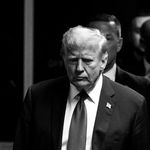
After watching a disastrous week unfold in Ferguson, Missouri, Americans have been buffeted by an endless stream of horrifying images and videos. A common theme united them: heavily armored police with military-grade weapons and vehicles facing down unarmed peaceful protesters furious over the killing of Michael Brown, and all too frequently firing upon them with tear gas and other “nonlethal” weapons.
The situation could have escalated even further, but yesterday, Governor Jay Nixon finally (and mercifully) ordered the local police stripped of their command. He instructed the state Highway Patrol to pick up the pieces, and that effort was led by Captain Ronald S. Johnson, an African-American who had grown up in the area. Johnson quickly explained that police would no longer be wearing gas masks and would, in short, be taking a much less antagonistic stance toward protesters.
This led to the remarkable photograph above, which was taken by Jon Swaine of the Guardian and tweeted out to his followers:
The contrast with the past few nights, when police manifested as a menacing, undifferentiated mass of armor and weaponry, couldn’t be starker. Yes, Johnson’s uniform marks him as different from the crowd in an important way, but he’s also a part of it. He’s not setting up off in the distance, behind armor and a bullhorn. The photo shows coordination and cooperation — clearly some sort of negotiation with the protesters took place beforehand, and clearly Johnson communicated that he wanted to be a part of their demonstration rather than a hostile authority figure standing in suspicious opposition to it.
What’s so bittersweet about Swaine’s photograph is that there’s little reason this couldn’t have happened from the start. Instead, the authorities, as is so often the case in an age in which seemingly every small-town cop has access to weapons better suited for all-out war, decided to set up a clear battle line against Them — those dangerous, out-of-control protesters.
In addition to the obvious takeaways about race and police militarization, this week has been an abject lesson in what happens when fear takes hold and strangles empathy. Solving all the deep-seated societal problems that led to Michael Brown’s killing and the subsequent outrages will be unimaginably complicated. What’s in this photo, though, is remedial — it’s about empathy, about treating people like human beings rather than dangerous others. This week, lessons usually internalized by the end of kindergarten were lost amid flurries of rubber bullets and choking hazes of tear gas. But last night, the air cleared; cop and demonstrater could again see each other.
An 18-year-old is still dead, of course, and Ferguson still faces a painful reckoning as the investigation into both his killing and the police’s treatment of protesters ramps up. But hopefully the image of Johnson marching peacefully next to demonstrators will endure, despite all the ugliness we’ve seen.




